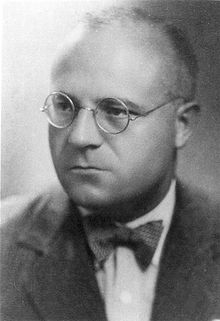Ivan Stranski
Iwan Nikolow Stranski ( Bulgarian Иван Николов Странски ; English transcription Ivan Nikolov Stranski ; born January 2, 1897 in Sofia , Bulgaria ; † June 19, 1979 ibid) was a Bulgarian physical chemist who lived mainly in Berlin from 1944 until his death, where the most important stations of his scientific career were. Stranski did fundamental theoretical work on surface chemistry and crystal growth, which is why he is often referred to as the "father of crystal growth research". One of the basic mechanisms of crystal growth, the Stranski-Krastanow growth , or the Kossel-Stranski theory are still associated with his name today.
Life
Stranski was born as the son of the Bulgarian court pharmacist Nikola I. Stranski and his wife Maria, née Krohn, a Baltic German woman from the then Russian province of Livonia . He attended elementary school and the semiclassical section of the 1st boys' grammar school in Sofia, and in 1915 he passed the high school diploma. He first began studying medicine, then switched to biology and began studying chemistry at the University of Vienna in 1918, which he later continued at the University of Sofia, where he graduated with a diploma. At the Friedrich-Wilhelms-Universität Berlin he turned to physical chemistry and was awarded a Dr. phil. PhD.
After being accepted as a foreign member of the Bulgarian Academy of Sciences in 1966, Stranski visited his homeland more often. During one of these visits he died in Sofia. He was buried in the Dahlem forest cemetery in Berlin.
Scientific career
From 1926 he worked as a lecturer in physical chemistry at the University of Sofia. Here he was appointed associate professor in 1929. With a grant from the Rockefell Foundation, he worked from 1929 to 1930 as a visiting scientist with Max Volmer at the Institute for Physical Chemistry at the Technical University of Berlin. From 1935 to 1936 he was head of department at the Urals Physical-Technical Institute in Sverdlovsk (USSR). In 1937 the University of Sofia appointed him full professor. From 1941 to 1944 he held a visiting professorship at the Institute for Physical Chemistry at the Technical University in Breslau . In 1944, the Kaiser Wilhelm Society appointed him Scientific Member of the Kaiser Wilhelm Institute for Physical Chemistry and Electrochemistry in Berlin-Dahlem , later the Fritz Haber Institute . From 1953 until his retirement in 1970 he was head of an independent department and deputy director of the institute.
In 1945 he was appointed full professor and director of the Institute for Physical Chemistry at the Technical University of Berlin as successor to Max Volmer. 1951–1953 he was rector of the university. In 1963 he retired.
Scientific awards and memberships
- Galvani Medal from the University of Bologna, 1938
- Silver Hofmann Medal of the German Chemical Society, Berlin, 1939
- Corresponding member of the Academy of Sciences in Göttingen , 1940
- Cyrillus Methodius Prize for Science from the Bulgarian Academy of Sciences, 1940
- Dr. rer. nat. hc from the University of Wroclaw, 1940
- Foreign membership of the Kungliga Vetenskaps- och Vitterhetssamhället i Göteborg , 1940
- Honorary doctorate from the Free University of Berlin in 1954
- Honorary membership of the German Mineralogical Society, 1954
- Since 1959 corresponding member of the Bavarian Academy of Sciences , Munich
- Name of a new mineral from the Tsumeb mine in Namibia by Hugo Strunz as Stranskiit , 1960
- Honorary Senator of the Technical University of Berlin 1963
- Great Cross of Merit of the Order of Merit of the Federal Republic of Germany, 1964
- Dr. Ing. E. h. of the Technical University of Aachen, 1964
- Dr. techn. hc from the Technical University of Vienna, 1964
- Foreign membership of the Bulgarian Academy of Sciences, Sofia, 1966
- Membership of the German Academy of Sciences Leopoldina , Halle, 1966
Trivia
Two research institutes in Germany bear his name:
- The I.-N.-Stranski Institute for Metallurgy in Oberhausen and
- the Stranski Laboratory for Physical and Theoretical Chemistry at the Technical University of Berlin (from 1967 to 2001 Iwan N. Stranski Institute).
literature
- Ivan S. Gutzow: Prof. Dr. Ivan N. Stranski (1897-1979): one of the Founders of Present-day Theory of Crystal Forms, Crystal Nucleation and Growth , in: Crystal Research and Technology 32 (2006), pp. 753-758.
Web links
- Literature by and about Iwan Stranski in the catalog of the German National Library
- Biography in the commemorative publication 125 years of the Technical University of Berlin
Individual evidence
- ^ Hans-Jürgen Mende: Lexicon of Berlin burial places . Pharus-Plan, Berlin 2018, ISBN 978-3-86514-206-1 , p. 588.
- ↑ Holger Krahnke: The members of the Academy of Sciences in Göttingen 1751-2001 (= Treatises of the Academy of Sciences in Göttingen, Philological-Historical Class. Volume 3, Vol. 246 = Treatises of the Academy of Sciences in Göttingen, Mathematical-Physical Class. Episode 3, vol. 50). Vandenhoeck & Ruprecht, Göttingen 2001, ISBN 3-525-82516-1 , p. 234.
- ^ Reasons for awarding honorary doctorates at the FU Berlin ( Memento from January 12, 2008 in the Internet Archive ) - Honorary doctorate from the FU Berlin, awarded on June 19, 1954
- ↑ Bavarian Academy of Sciences: Prof. Dr. Ivan Stranski , members of the Bavarian Academy of Sciences - deceased members (S)
- ↑ Award of the academic dignity of Honorary Senator to Professor Dr. phil. habil. Johannes Erich Heyde and Professor Dr. rer. nat. hc Dr. rer. nat. hc Dr. phil. Iwan N. Stranski by the Technical University, Berlin, July 15, 1963 . In: Technische Universität Berlin: Academic Speeches 24 , Berlin: 1963.
| personal data | |
|---|---|
| SURNAME | Stranski, Ivan |
| ALTERNATIVE NAMES | Stranski, Iwan N .; Stranski, Ivan Nikolow (full name) |
| BRIEF DESCRIPTION | German physical chemist |
| DATE OF BIRTH | January 2, 1897 |
| PLACE OF BIRTH | Sofia |
| DATE OF DEATH | June 19, 1979 |
| Place of death | Sofia |
